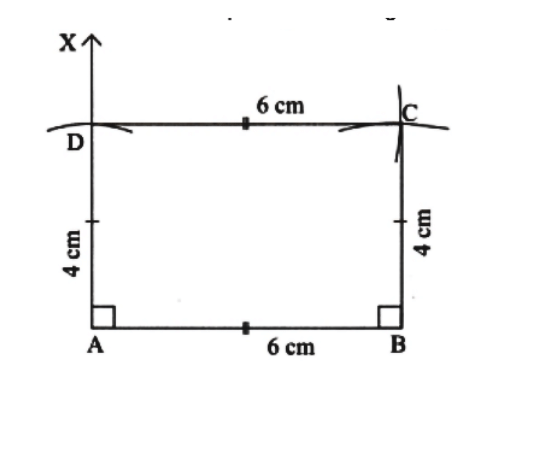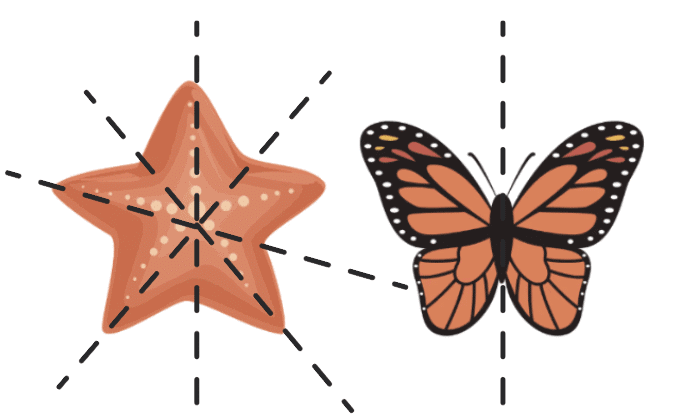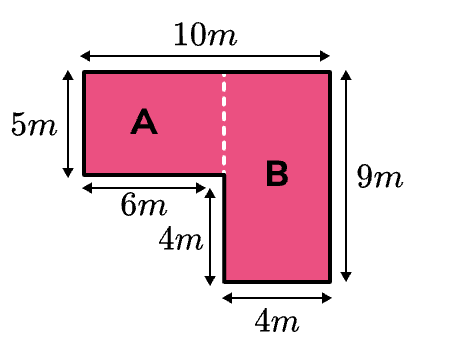Class 6 Mathematics: Sample Paper Solutions - 1 | Sample Papers For Class 6 PDF Download
General Instructions
All questions are compulsory.
- Section A comprises 12 questions carrying 1 mark each.
- Section B comprises 10 questions carrying 2 marks each.
- Section C comprises 8 questions carrying 3 marks each.
- Section D comprises 2 questions carrying 5 marks each.
Q1: How many lines of symmetry does a regular hexagon have? (1 mark)
(a) 3
(b) 4
(c) 6
(d) 8
Ans: (c)
A regular hexagon has 6 lines of symmetry.
Q2: The perimeter of a square is 20 cm. What is the length of one side? (1 mark)
(a) 4 cm
(b) 5 cm
(c) 10 cm
(d) 8 cm
Ans: (b)
Perimeter of square = 20 cm → Side = 20 ÷ 4 = 5 cm.
Q3: In the fraction 5/6, what is 5 called? (1 mark)
(a) Denominator
(b) Quotient
(c) Numerator
(d) Whole number
Ans: (c)
In 5/6, 5 is the numerator.
Q4: Convert the improper fraction 11/4 into a mixed fraction. (1 mark)
(a) 
(b) 
(c) 
(d) 
Ans: (b)
11 ÷ 4 = 2 with a remainder of 3
So,
11/4 =
Q5: The temperature in a city is -5°C in the morning. By noon, it rises by 8°C. What is the temperature at noon? (1 mark)
(a) 3°C
(b) -3°C
(c) 5°C
(d) -13°C
Ans: (a)
Temperature at noon = -5°C + 8°C = 3°C
Q6: Add the following fractions using Brahmagupta's method: (1 mark)
3/8 + 5/8
(a) 8/8
(b) 3/16
(c) 5/16
(d) 1/2
Ans: (a)
3/8 + 5/8 = 8/8 = 1
Q7: Which of the following pairs of numbers are co-prime? (1 mark)
(a) 8 and 12
(b) 15 and 35
(c) 9 and 16
(d) 10 and 20
Ans: (c)
Co-prime pair is 9 and 16 (no common factors other than 1).
Q8: What is a pictograph? (1 mark)
(a) A graph that uses pictures or objects to represent data
(b) A bar graph with horizontal bars
(c) A method to calculate frequencies
(d) A mathematical operation
Ans: (a)
A pictograph uses pictures to represent data.
Q9: A figure has rotational symmetry if it can be rotated by an angle less than __ and still look the same. (1 mark)
(a) 90°
(b) 180°
(c) 360°
(d) 270°
Ans: (c)
Rotational symmetry requires rotation by 360° to look the same.
Q10: Where can fractions be represented visually? (1 mark)
(a) Number line
(b) Pie chart
(c) Only in decimal form
(d) In whole numbers
Ans: (a)
Fractions can be represented on a number line.
Q11: Find the missing number in the pattern: (1 mark)
100, 90, 80, __, 60
(a) 50
(b) 70
(c) 65
(d) 55
Ans: (b)
Pattern: Subtract 10 → 100, 90, 80, 70, 60.
Q12: An obtuse angle is always: (1 mark)
(a) Less than 90°
(b) Equal to 90°
(c) More than 90° but less than 180°
(d) More than 180° but less than 360°
Ans: (c)
An obtuse angle is >90° but <180°.
Q13: Aarav is arranging chairs in a triangular pattern. The first row has 2 chairs, the second row has 5 chairs, the third row has 9 chairs, and the fourth row has 14 chairs. If he continues this pattern, how many chairs will be in the fifth row? (2 marks)
Ans: The pattern increases by consecutive odd numbers:
- 1st row = 2
- 2nd row = 2 + 3 = 5
- 3rd row = 5 + 4 = 9
- 4th row = 9 + 5 = 14
- 5th row = 14 + 6 = 20
The fifth row will have 20 chairs.
Q14: Construct a rectangle having adjacent sides of 6 cm and 4 cm. (2 marks)
Ans: Steps for construction:
Step 1: Draw a rough diagram and mark the given measurements.
Step 2: Draw a line segment AB = 6 cm.
Step 3: At A, using a protractor draw AX JL AB.
Step 4: With A as centre, draw an arc of radius 4 cm and let it cut AX at D.
Step 5: With D as centre, draw an arc of radius 6 cm above the line segment AB.
Step 6: With B as centre, draw an arc of radius 4 cm cutting the previous arc at C. Join BC and CD. Thus, ABCD is the required rectangle.
Q15: What is the sum of the smallest and largest 6-digit palindrome? What is their difference? (2 marks)
Ans: The smallest 6-digit palindrome = 100001
The largest 6-digit palindrome = 999999Sum = 100001 + 999999 = 1100000
Difference = 999999 - 100001 = 899998
Q16: Subtract 3 from -4 using a number line. (2 marks)
Ans:
Q17: Write two equivalent fractions for 3/7. (2 marks)
Ans: Here,
Here,
are equivalent fractions of 3/7
Q18: A square-shaped rug has a side length of 9 m. Find its area. (2 marks)
Ans: Area of a square = side × side
= 9 × 9
= 81 sq. m
Q19: Below is a sequence of matchstick patterns. Observe the pattern carefully and continue it forward. also, give number pattern for the same : (2 marks) 
Number of matchsticks: 3, 5, 7, __ , __
Ans:
It follows a pattern where each number increases by 2.
- Next term: 7 + 2 = 9
- Next term: 9 + 2 = 11
Number of matchsticks: 3, 5, 7, 9, 11
Q20: Do you see any Line of symmetry in the figures given below? (2 marks) 
Ans: Starfish have 5 arms, so they exhibit 5 lines of symmetry.
Butterfly has 1 line of symmetry.
Q21: Can you find the pattern and fill in the missing numbers and justify your answer? (2 marks) 
Ans:
Each number increases by 4:
- 11+4=15
- 15+4=19
- 19+4=23
- 23+4=27
- 27+4=31
Missing numbers are :
Q22: Is the first number divisible by the second? Use prime factorization. (2 marks)
(a) 180 and 45
Ans: The prime factorization of 180 is 2 × 2 × 3 × 3 × 5, and the prime factorization of 45 is 3 × 3 × 5.
Since 180 has all the factors of 45, it is divisible by 45.
Yes, 180 is divisible by 45.
(b) 784 and 14
Ans: The prime factorization of 784 is 2 × 2 × 2 × 2 × 7 × 7, and the prime factorization of 14 is 2 × 7.
Since 784 has all the factors of 14, it is divisible by 14.
Yes, 784 is divisible by 14.
Q23: Find the area of the shaded portion in the given figure .(3 marks) 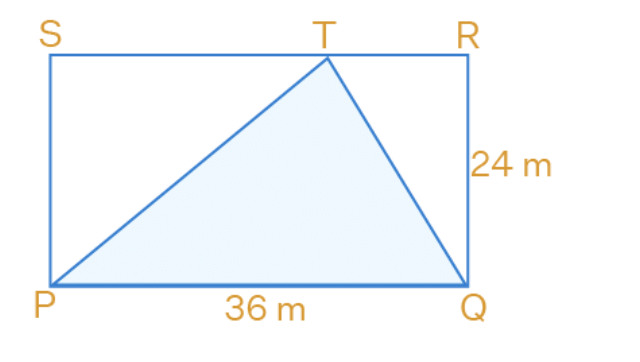
Ans: The area of the shaded area in the above diagram is given by the Area of △PTQ which is calculated as below:
Area of △PTQ = 1/2 × Base × height
Area of △PTQ = 1/2 × 36 × 24 = 432m2
Q24: A rectangular parking lot is 500 m long and 200 m wide. If the cost of painting the parking lines is ₹8 per 100 sq. m, what is the total cost to paint the entire lot? (3 marks)
Ans: Here, length = 500 m and width = 200 m
Hence, the area of the parking lot = length × width
= 500 × 200
= 1,00,000 sq. mNow, the cost of painting 100 sq. m = ₹8
Total cost = (8/100) × 100000
= ₹8,000
Q25: A strip of width 3 m is cut out all round from a sheet of paper with dimensions 50 m × 30 m. Find the area of the strip cut out and the area of the remaining sheet. (3 marks) 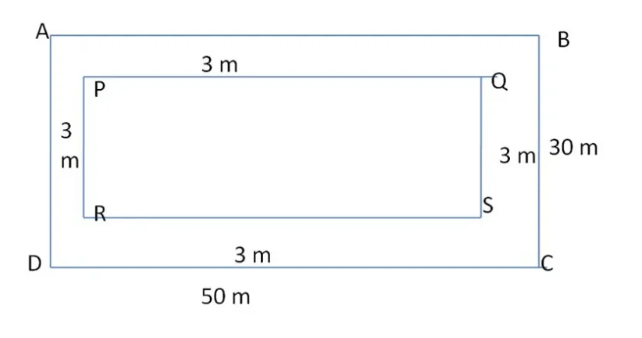
Ans: Given that,
Length of the sheet = 50 m
Breadth of the sheet = 30 m
Area of the sheet = 50 x 30 = 1500 m²
A strip of width 3 cm is cut out all round from a sheet of paper
Let that form a rectangle PQRS
Length of the rectangle PQRS = 50 – 3 – 3 = 50 – 6 = 44 m
Breadth of the rectangle = 30 – 3 – 3 = 30 – 6 = 24 m
Area of the rectangle PQRS (Area of remaining sheet) = 44 x 24 = 1056 m²
Area of the strip cut out = Area of ABCD – Area of PQRS
= 1500 – 1056
= 444 m²
∴ The area of the strip cut out 444 m2.
Q26: identify the type of angles made by clock's hands (3 marks) 
Ans:
Q27: Identify the type of angle : (3 marks) 
Ans:
Q28: Draw a tally marks table for the following data: (3 marks)
A, B, A, B, C, D, E, D, C, B, A, E, C, D, B, E, A, E, C, D, B, E, C.
Ans:
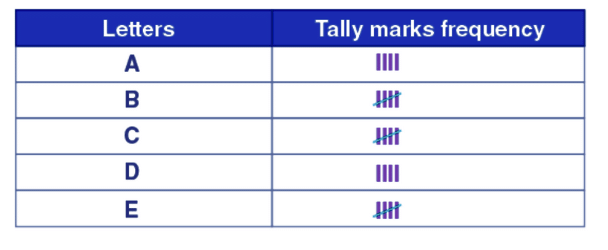
Q29: Find the area of the shape below: (3 marks) 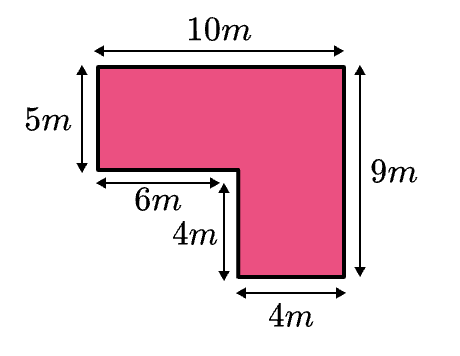
Ans: Split the shape into two rectangles.
Area of A:
Area (A)= length × width = 6×5 = 30m2
Area of B:
Area (B)= length × width = 9×4 = 36m2
Total Area = Area (A)+ Area (B) = 30+36 = 66m2
Q30: The temperature in a city at 6 AM was 3°C. Due to a cold wave, the temperature dropped by 7°C by 10 AM. Later in the afternoon, as the sun came out, the temperature rose by 5°C. By night, it again fell by 6°C. (3 marks)
(A) What was the temperature at 10 AM?
(B) What was the temperature in the afternoon?
(C) What was the temperature at night?
Ans: (A) At 10 AM:
3−7=−4
The temperature was -4°C.
(B) In the afternoon:
−4+5=1
The temperature was 1°C.
(C) At night:
1−6=−5
The temperature was -5°C.
Q31: On the number line mark the following numbers : 5, 0, -3, -9 (5 marks)
Ans:
Q32: Read and Answer the Pictograph Questions (5 marks)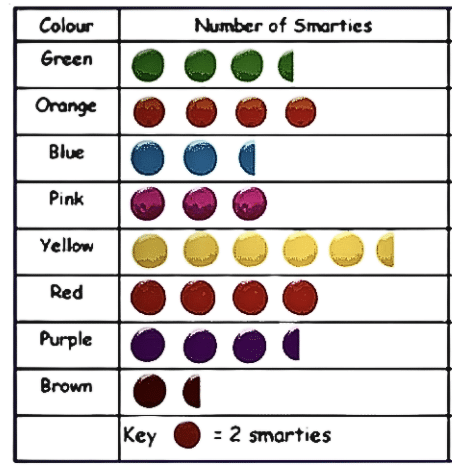
(i) How many green smarties are there? ______________________
(ii) How many brown smarties are there? ______________________
(iii) Which color is the most popular smartie? ______________________
(iv) Which color is the least favorite smartie? ______________________
(v) How many more yellow smarties are there than pink smarties? ______________________
(vi) How many more purple smarties are there than blue smarties? ______________________
(vii) How many more red smarties are there than brown smarties? ______________________
(viii) How many smarties are there altogether? ______________________
Ans:
(i) 7
(ii) 3
(iii) Yellow
(iv) Brown
(v) Yellow smarties = 11
Pink smarties = 6
Difference = 11 - 6 = 5
(vi) Purple smarties = 7
Blue smarties = 5
Difference = 7 - 5 = 2
(vii) Red smarties = 5
Brown smarties = 3
Difference= 5-3 =2


